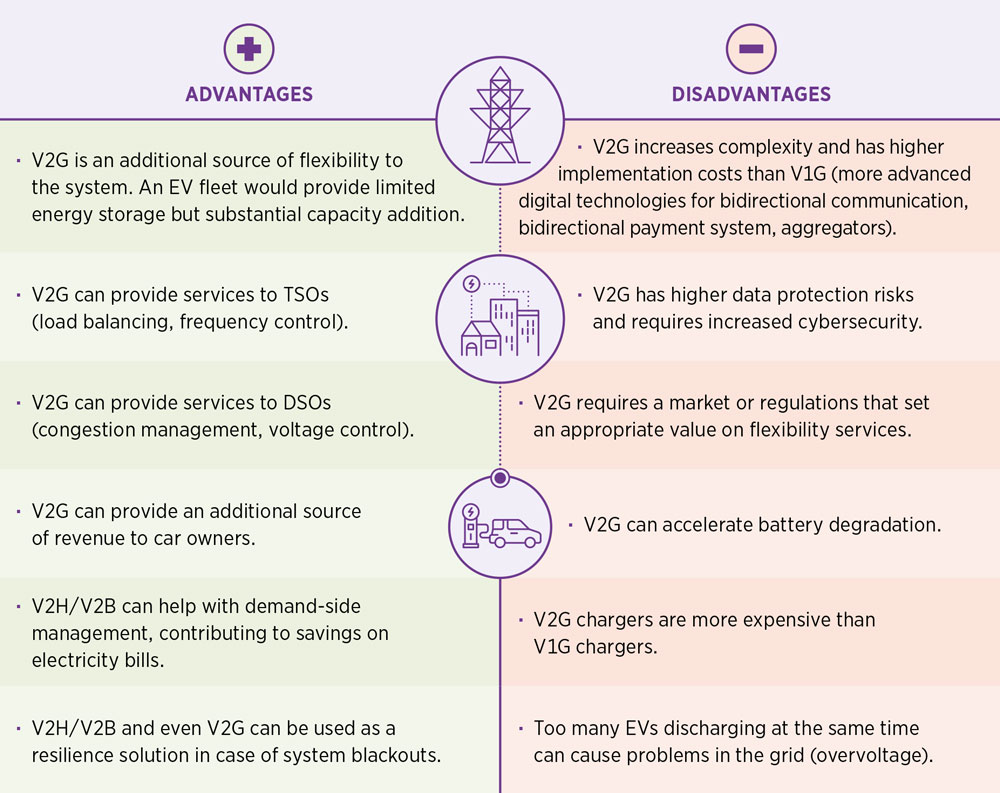Power to mobility: Smart charging kit
Smart charging kit
The smart charging kit adds onto the essential kit to ensure that the electrification strategy is
executed in a smart way, minimising the impact of uncontrolled charging on the power system. It
is a mandatory step because it identifies the most suitable strategy based on the specific power
system and the country context and includes innovations in market design and regulation to ensure
adequate remuneration for the services provided to the power system.
Smart charging can be unidirectional (V1G) or bidirectional (V2G) (Table 2.4). While both require
advanced digital infrastructure for energy management and information collection, bidirectional
charging also requires V2G technology, which can be costly and difficult to add to a V1G charging
infrastructure once the latter is deployed. Whether or not to include V2G charging, therefore, should
be decided at the early stages of planning for a given location or project.
For V2G, one key innovation is a V2G grid connection code to boost deployment and allow EVs to
smartly exchange energy with the grid. All the other innovations in this kit are important for both
unidirectional and bidirectional charging. Bidirectional charging allows more service options but
also increases complexity (Box 2.1).
BOX 2.1 Bidirectional charging: When does it make sense?
By allowing plugged-in EVs to feed energy to the grid (V2G) or to homes (V2H) or other buildings (V2B), bidirectional charging systems turn EVs into an energy storage asset. When plugged in, electric cars can power homes, balance grid loads, provide frequency control and power support, and replace traditional spinning reserves. Personal EVs are parked more than 80% of the time; so they have the potential to be a major source of stored electricity.
However, implementing V2G charging systems presents challenges. One is the need for more complex and costly bidirectional chargers, communication systems and payment methods so that EV owners can be paid for the energy they provide. Another is valuing the services and flexibility that EVs provide to the grid.
The additional charging and discharging of EV batteries in V2G systems also can cause faster battery degradation and shorter battery lifetimes, creating an unwanted expense for EV owners. However, degradation can be minimised with improved battery control systems.
In any specific deployment, the benefits of V2G need to be carefully assessed against the costs. If a system already has a flexible generation fleet or good interconnections with neighbouring systems, for example, the added costs of implementing a V2G system may not be worthwhile, since other flexibility sources are available at lower costs. The deployment should also consider whether V2G could cause problems if too many EV owners respond to high electricity prices by discharging their batteries, which could cause voltage problems on the grid.
But even if V2G does not make economic sense for system operators, a business case might still exist for bidirectional charging in V2H and V2B settings by allowing consumers to manage their demand and decrease their electricity bills, and by providing back-up power during power outages (Table 2.5).
TABLE 2.5 Advantages and disadvantages of V2G
